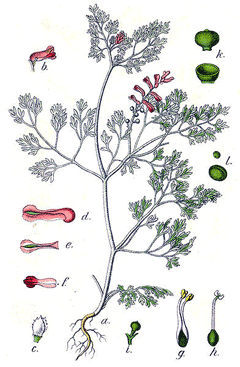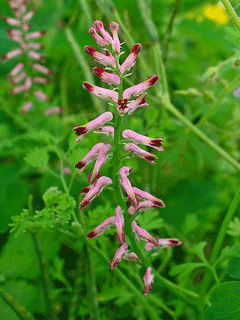 |
|
http://commons.wikimedia.org/wiki/File:Fumaria_officinalis_Sturm46.jpg |
 |
| http://commons.wikimedia.org/wiki/User:Llez |
Translate this page:
Summary
Physical Characteristics

 Fumaria officinalis is a ANNUAL growing to 0.3 m (1ft) by 0.3 m (1ft in).
Fumaria officinalis is a ANNUAL growing to 0.3 m (1ft) by 0.3 m (1ft in).
See above for USDA hardiness. It is hardy to UK zone 5 and is not frost tender. It is in flower from May to September, and the seeds ripen from July to October. The species is hermaphrodite (has both male and female organs) and is pollinated by Bees, flies. The plant is self-fertile.
Suitable for: light (sandy) and medium (loamy) soils. Suitable pH: mildly acid, neutral and basic (mildly alkaline) soils. It can grow in semi-shade (light woodland) or no shade. It prefers moist soil.
UK Hardiness Map
US Hardiness Map
Synonyms
Fumaria cirrhata. Fumaria diffusa. Fumaria disjuncta. Fumaria pulchella.
Plant Habitats
Cultivated Beds; East Wall. In. South Wall. In. West Wall. In.
Edible Uses
Edible Parts:
Edible Uses: Curdling agent
The fresh or dried herb can be added to sour plant milks. A few sprays are added to each litre of liquid and left until the liquid has soured thickly. The sprays are then removed. It gives a tangy taste to the milk, acts as a preservative and prevents the rancid taste that can accompany soured milk[183].
References More on Edible Uses
Medicinal Uses
Plants For A Future can not take any responsibility for any adverse effects from the use of plants. Always seek advice from a professional before using a plant medicinally.
Antirheumatic Antispasmodic Aperient Cholagogue Diaphoretic Diuretic Eczema Laxative
Tonic
Fumitory has been highly valued since at least Roman times for its tonic and blood cleansing effect upon the body[244]. It is particularly valuable in the treatment of all visceral obstructions, particularly those of the liver, in scorbutic affections and in troublesome eruptive diseases of the skin, especially eczema (for which it can be taken internally and externally)[4, 9, 238]. The herb is antispasmodic, aperient, cholagogue, slightly diaphoretic, mildly diuretic, laxative and weakly tonic[4, 9, 21, 165, 240]. The plant is harvested as flowering begins in the summer and can be used fresh or can be dried for later use[9, 238]. Some caution should be exercised in the use of this herb since excess doses cause hypnotic and sedative effects, especially if it is taken for more than about 8 days[238, 244].
References More on Medicinal Uses
The Bookshop: Edible Plant Books
Our Latest books on Perennial Plants For Food Forests and Permaculture Gardens in paperback or digital formats.

Edible Tropical Plants
Food Forest Plants for Hotter Conditions: 250+ Plants For Tropical Food Forests & Permaculture Gardens.
More

Edible Temperate Plants
Plants for Your Food Forest: 500 Plants for Temperate Food Forests & Permaculture Gardens.
More

More Books
PFAF have eight books available in paperback and digital formats. Browse the shop for more information.
Shop Now
Other Uses
Baby care Dye
A yellow dye is obtained from the flowers[4, 21]. A decoction makes a curative lotion for 'milk-crust' on the scalps of babies[4].
Special Uses
References More on Other Uses
Cultivation details
Prefers a light well-drained soil in a sunny position[9, 17, 238]. This plant can be a common weed in some gardens, self-sowing freely, though it is fairly easy to control by hand weeding[K]. The flowers are seldom visited by insects, but they are self-fertile and usually set every seed[4].
References Carbon Farming Information and Carbon Sequestration Information
Temperature Converter
Type a value in the Celsius field to convert the value to Fahrenheit:
Fahrenheit:
The PFAF Bookshop
Plants For A Future have a number of books available in paperback and digital form. Book titles include Edible Plants, Edible Perennials, Edible Trees,Edible Shrubs, Woodland Gardening, and Temperate Food Forest Plants. Our new book is Food Forest Plants For Hotter Conditions (Tropical and Sub-Tropical).
Shop Now
Plant Propagation
Seed - sow spring in situ. There is normally very little need to sow this seed, the plant normally self-sows freely and should manage quite nicely by itself.
Other Names
If available other names are mentioned here
Native Range
TEMPERATE ASIA: Cyprus, Iraq, Israel, Lebanon, Syria, Turkey, Russian Federation-Ciscaucasia (Ciscaucasia), Russian Federation-Western Siberia (Western Siberia) EUROPE: Denmark, United Kingdom, Ireland, Norway, Sweden, Austria, Belgium, Switzerland, Germany, Hungary, Netherlands, Poland, Slovakia, Russian Federation (European part), Belarus, Estonia, Lithuania, Latvia, Ukraine (incl. Krym), Albania, Bulgaria, Bosnia and Herzegovina, Greece (incl. Crete), Croatia, Italy (incl. Sardinia, Sicily), Montenegro, Romania, Serbia, Slovenia, Spain (incl. Baleares), France (incl. Corsica), Portugal AFRICA: Spain (Canarias), Algeria, Egypt, Libya, Morocco, Tunisia
Weed Potential
Right plant wrong place. We are currently updating this section.
Please note that a plant may be invasive in one area but may not in your area so it's worth checking.
Conservation Status
IUCN Red List of Threatened Plants Status :

Growth: S = slow M = medium F = fast. Soil: L = light (sandy) M = medium H = heavy (clay). pH: A = acid N = neutral B = basic (alkaline). Shade: F = full shade S = semi-shade N = no shade. Moisture: D = dry M = Moist We = wet Wa = water.
Now available:
Food Forest Plants for Mediterranean Conditions
350+ Perennial Plants For Mediterranean and Drier Food Forests and Permaculture Gardens.
[Paperback and eBook]
This is the third in Plants For A Future's series of plant guides for food forests tailored to
specific climate zones. Following volumes on temperate and tropical ecosystems, this book focuses
on species suited to Mediterranean conditions—regions with hot, dry summers and cool, wet winters,
often facing the added challenge of climate change.
Read More
Expert comment
Author
L.
Botanical References
17
Links / References
For a list of references used on this page please go here
Readers comment